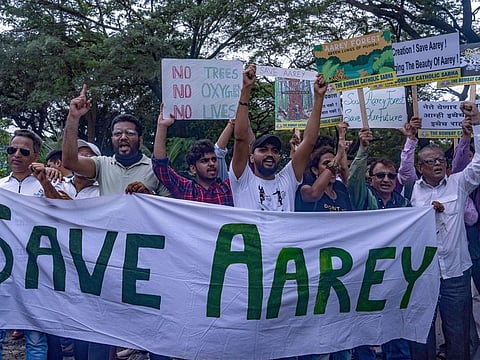India: A political tug of war over Mumbai’s Aarey forest
Maharashtra move to relocate Metro car shed to forest patch angers environmentalists

Barely hours after assuming office and in one of its first decisions, the Eknath Shinde government in the western Indian state of Maharashtra reversed the order on Mumbai Metro’s controversial car shed by announcing that it will be moved back to Aarey forest, a proposed step that has once again raised the hackles of environmentalists and citizens who accuse the move to be a threat to the biodiversity of a forest.
Shinde government’s decision is also being seen more as a quid pro quo since Uddhav Thackeray too had struck down plans of the previous BJP government immediately after forming a government and declared 800 acres of Aarey as reserved forest. After widespread protests, his government had in 2020 moved the location to salt pan Kanjurmarg, but controversy has dogged this project at every step. The substitute land has been mired in a legal tussle of ownership between the centre and state with the Bombay High Court staying any construction.
That there is a political mix in the development plank is not disputable. “Don’t take out your anger against me or the people of Mumbai,” Uddhav Thackeray, who was recently ousted, responded to the new notification, but BJP’s Devendra Fadnavis insists that 25% of the work on the project has already been completed and any change will be an additional cost. Fadnavis was the chief minister when work started on the car shed and is now ostensibly downgraded to a deputy, although snatching the microphone from Shinde in a press conference sends out its own message.
The Aarey controversy dates back to 2019 when activists were arrested and section 144 imposed following the overnight felling of more than 2,000 trees by the Mumbai Metro Rail Corporation to make way for a shed to park the metro bogeys.
The new state chief minister though is himself a recent convert. As the Urban Development Minister in the Maha Vikas Aghadi government under Uddhav Thackeray, Shinde had not just supported the move to shift the car shed from Aarey but also spearheaded it saying it was in the larger public interest. At the time, he claimed that the BJP was playing politics by blocking the move to Kanjurmarg; it is hard to be convinced that his change of tune is a sudden love for development.
The Aarey controversy dates back to 2019 when activists were arrested and section 144 imposed following the overnight felling of more than 2,000 trees by the Mumbai Metro Rail Corporation to make way for a shed to park the metro bogeys. The Fadnavis government had claimed that without the car shed the Metro 3 A line for the underground Colaba-Bandra-Seepz Metro project cannot take off, a tune that Shinde is suddenly singing too.
In a city like Mumbai that is bursting at the seams, the proposed location is a 1,800-hectare forest patch adjoining the Sanjay Gandhi National Park and is considered Mumbai’s green lung, a rare oasis among the concrete and congestion. It is also home to flora and fauna that experts claim to need protection, along with being a catchment area for the Mithi river. Already there is a cost to pay for earlier urbanisation, since 1971, 700 acres have been allotted for, among other departments, a film city allowing for the natural habitat to merge with construction. Just this week, a leopard was spotted at night prowling in the Aarey colony. Environmentalists warn that this will just be a precursor to animal-man conflict as development further encroaches on a forest rich in wildlife.
The Aarey milk colony is also home to 10,000 tribals who are part of 27 tribal hamlets that once inhabited the outskirts of Mumbai but slowly fused in with the city as industrialisation expanded. They have helped maintain an ecological balance in the city, surviving on what they grow as well as natural resources. The displacement of the indigenous tribes will not just be about the land but also a way of life that on the contrary needs special protection, compensation for this tribal village cannot be measured only in terms of losing a home.
While development is non-negotiable, and the conditions of overpowered local Mumbai trains do need a think, in this instance, it does come with a caveat. Development and environment are not part of a binary stack. What could be a bigger warning than the unfolding of long-term ecological impacts?
There have been recent claims that forest cover in the country has increased, but experts question the change in mapping methodology that now includes tea plantations in the definition of forest covers. The reality they say is grim, natural forests are on the decline and uprooting trees from a forest and planting a similar number elsewhere as a solution, as the Maharashtra government claims, does not balance out deforestation.
For real development, all stakeholders need to be taken into confidence with more than a superficial eye on the loss of conservation. Otherwise, like Aarey, there will always be a lingering doubt that concerns are waylaid by political motives.
Sign up for the Daily Briefing
Get the latest news and updates straight to your inbox








